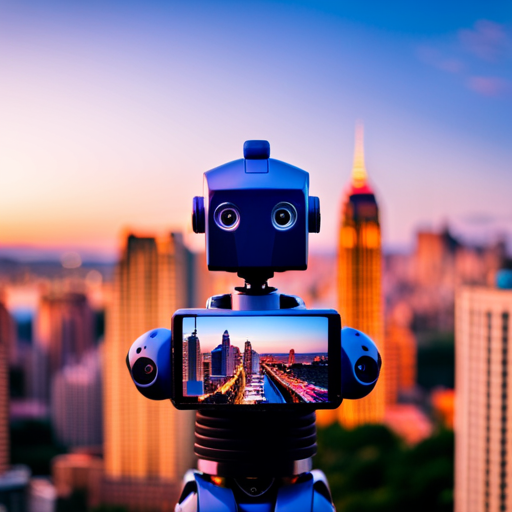Are you interested in the legal aspects of AI for autonomous vehicles? Understanding liability and regulation is crucial in this rapidly evolving field.
In this article, we will explore the legal landscape surrounding AI in autonomous vehicles, highlighting key liability issues and current regulations.
We will also discuss the challenges and future directions of AI regulation for autonomous vehicles.
Stay tuned to learn best practices for navigating liability and regulation in AI for autonomous vehicles.
Key Takeaways
– Clear guidelines and regulations are crucial for ensuring the safety and accountability of autonomous vehicles.
– Ethical principles should be incorporated into the design and use of AI systems.
– Driver responsibility boundaries need to be understood in cases involving AI technology.
– Manufacturers and suppliers bear the responsibility for accidents caused by their autonomous vehicles.
The Importance of Liability and Regulation in AI for Autonomous Vehicles
@ Midjourney AI Image Prompt: /imagine prompt:Create an image depicting a bustling city street with autonomous vehicles zipping past pedestrians. Showcase a collision between a pedestrian and an autonomous vehicle, emphasizing the need for clear liability and regulation in AI for autonomous vehicles. –v 5.2 –ar 16:9
You need to understand the importance of liability and regulation in AI for autonomous vehicles.
As technology advances and self-driving cars become more prevalent, it is crucial to establish clear guidelines and regulations to ensure the safety and accountability of these vehicles. Liability is a key aspect that needs to be addressed, as accidents involving autonomous vehicles may occur due to system malfunctions or errors. Determining who is responsible for these accidents can be a complex issue, as it involves multiple parties such as manufacturers, software developers, and even the vehicle owners. Without proper liability regulations in place, it can be challenging to allocate responsibility and provide compensation to the affected parties.
Moreover, regulation is essential to ensure that autonomous vehicles operate within legal boundaries. Government bodies and regulatory agencies need to establish standards and guidelines for the development, testing, and deployment of AI in autonomous vehicles. These regulations can help enforce safety protocols, address ethical concerns, and minimize the risks associated with autonomous driving. By having a clear framework in place, it becomes easier to hold manufacturers and developers accountable for any wrongdoing or negligence in the design or implementation of AI systems.
Understanding the Legal Landscape for AI in Autonomous Vehicles
@ Midjourney AI Image Prompt: /imagine prompt:Create an image depicting an intricate web interconnecting elements of autonomous vehicles, AI, and law. Include icons representing regulations, liability, and technology, illustrating the complex legal landscape surrounding AI in autonomous vehicles. –v 5.2 –ar 16:9
When it comes to liability in AI accidents, you need to consider the legal implications and who should be held responsible.
Regulatory challenges and compliance are also important factors to address in the legal landscape of AI for autonomous vehicles.
Additionally, ethical considerations in AI play a crucial role in shaping the framework for responsible use and development of AI technologies.
Liability for AI Accidents
If an autonomous vehicle equipped with AI technology causes an accident, it’s crucial to understand the liability implications. As a driver, you need to be aware of who is responsible for the accident and who should be held accountable. In the world of autonomous vehicles, the lines of liability can become blurred. To help you navigate this complex landscape, let’s take a look at a table outlining the key players and their potential liability in AI accidents:
| Player | Potential Liability |
|---|---|
| AI Developer | Design or coding flaws |
| Vehicle Manufacturer | Manufacturing defects |
| Owner/Operator | Negligent maintenance or operation |
| Government | Inadequate regulations or oversight |
Regulatory Challenges and Compliance
Understanding the potential challenges and ensuring compliance with regulations is crucial in the field of autonomous vehicles equipped with AI technology. As a developer or manufacturer, you must navigate the complex regulatory landscape to ensure that your autonomous vehicles meet the necessary standards and requirements.
This includes obtaining the appropriate permits, licenses, and certifications from regulatory bodies. Additionally, you must stay up to date with evolving regulations and guidelines, as they can change rapidly in this fast-paced industry.
Failure to comply with regulations can lead to legal consequences, financial penalties, and damage to your reputation. It is important to establish processes and protocols within your organization to ensure ongoing compliance and to address any potential challenges that may arise.
Ethical Considerations in AI
Ethical considerations play a crucial role in the development and deployment of AI technology in various industries. As an AI developer or user, you must be aware of the ethical implications of your actions.
AI systems can have a significant impact on individuals, society, and even the environment. It is your responsibility to ensure that the AI system you create or use adheres to ethical principles. This includes ensuring fairness and non-discrimination, transparency, and accountability.
You should also consider the potential risks and unintended consequences of AI technology, such as job displacement or privacy concerns. By incorporating ethical considerations into the design and implementation of AI systems, you can help ensure that these technologies are used responsibly and for the benefit of all.
Key Liability Issues in AI for Autonomous Vehicles
@ Midjourney AI Image Prompt: /imagine prompt:Create an image of a tangled highway with multiple traffic signs, representing the complex legal landscape surrounding AI for autonomous vehicles. Use vibrant colors to depict the intricate web of liability issues, highlighting the challenges faced in this evolving industry. –v 5.2 –ar 16:9
In this discussion, you’ll explore three key liability issues in AI for autonomous vehicles.
First, let’s examine the driver responsibility boundaries in cases where AI technology is involved.
Next, we’ll delve into the product liability implications for manufacturers and developers of autonomous vehicles.
Lastly, we’ll explore the legal challenges faced by insurers in adapting their policies to the unique risks and uncertainties associated with AI-driven vehicles.
Driver Responsibility Boundaries
You need to know where the boundaries of driver responsibility lie when it comes to autonomous vehicles. With the advancement of technology, the role of the driver has become blurred. While autonomous vehicles are designed to operate without human intervention, there are still situations where the driver may need to take control. Here’s a table to help you understand the driver responsibility boundaries:
| Situation | Driver Responsibility | Autonomous Vehicle Responsibility |
| Normal operation | Minimal supervision | Primary responsibility |
| Emergency stop | Primary responsibility | Minimal supervision |
| System failure | Primary responsibility | Minimal supervision |
| Handover | Primary responsibility | Minimal supervision |
It is important to note that laws and regulations regarding autonomous vehicles vary by jurisdiction. Understanding your responsibilities as a driver will help ensure a safe and smooth transition to the autonomous vehicle era.
Product Liability Implications
Now let’s delve into the product liability implications surrounding AI for autonomous vehicles.
As a driver, you may be wondering who is responsible if a self-driving car causes an accident. Well, the answer lies in the hands of the manufacturers and suppliers.
With the increasing use of AI technology in autonomous vehicles, the responsibility for any defects or malfunctions shifts from the driver to the companies behind the technology. If an AI system fails to function properly, leading to an accident, the manufacturers may be held accountable for any resulting damages or injuries.
This shift in liability raises important questions about the development and testing of AI systems, as well as the need for comprehensive regulations to ensure the safety and accountability of autonomous vehicles on our roads.
Legal Challenges for Insurers
With the increasing complexity of insurance claims in the realm of autonomous vehicles, you, as an insurer, are facing significant legal challenges. As the technology advances, so do the risks and uncertainties surrounding these vehicles. Here are some key issues you need to navigate:
– Determining Liability: Assigning blame in accidents involving autonomous vehicles can be a daunting task. The responsibility may lie with the vehicle manufacturer, software developer, or even the human in the loop.
– Legal Framework: The current legal framework is struggling to keep up with the rapid pace of technological advancements. Laws and regulations must be established to address issues like data privacy, cybersecurity, and accident liability.
– Updating Insurance Policies: As the risks evolve, traditional insurance policies may no longer be sufficient. You need to adapt your policies to cover the unique challenges posed by autonomous vehicles, such as software failures and cyber attacks.
Successfully addressing these challenges will be crucial for insurers to effectively navigate the legal landscape of autonomous vehicles.
Current Regulations for AI in Autonomous Vehicles
@ Midjourney AI Image Prompt: /imagine prompt:Create an image depicting a winding road signifying the legal landscape for AI in autonomous vehicles. Include traffic signs representing current regulations, such as speed limits, lane markings, and caution signs, to highlight the complex and evolving nature of the legal framework. –v 5.2 –ar 16:9
Although there’s still much progress to be made, it’s important to note that current regulations for AI in autonomous vehicles are beginning to take shape. As a driver, you may wonder what these regulations mean for the safety and operation of autonomous vehicles.
The good news is that governments and organizations are recognizing the need for guidelines to ensure the responsible development and deployment of AI in these vehicles.
One way these regulations are taking shape is through the establishment of safety standards. As an AI system becomes more sophisticated, it’s crucial to have a set of guidelines to evaluate its performance and ensure it meets certain safety requirements. By having these standards in place, it helps to build trust and confidence in the technology.
Another aspect of regulation is liability. As an AI takes control of a vehicle, questions arise about who is responsible in the event of an accident. Governments and insurers are actively working on defining liability frameworks to address these concerns. This will help determine who is at fault and provide a clear path for compensation in case of accidents.
Overall, while there is still work to be done, the fact that current regulations for AI in autonomous vehicles are beginning to take shape is a positive step forward. These regulations will help ensure the safe and responsible integration of AI technology into our roads, ultimately making the future of autonomous vehicles a reality.
Challenges and Future Directions in AI Regulation for Autonomous Vehicles
@ Midjourney AI Image Prompt: /imagine prompt:Create an image depicting a winding road with traffic signs and barriers, symbolizing the complex challenges of AI regulation for autonomous vehicles. Show futuristic elements hinting at the evolving nature of this field. –v 5.2 –ar 16:9
As a driver, you may face challenges when it comes to ensuring the safe and ethical use of AI in autonomous vehicles.
One of the major challenges is the lack of clear regulations surrounding AI in autonomous vehicles. Currently, there is no uniform regulatory framework in place that specifically addresses the use of AI in autonomous vehicles. This creates uncertainty and can make it difficult for drivers to understand their responsibilities and liabilities.
Another challenge is the potential for biases in AI algorithms. Autonomous vehicles rely on AI to make decisions on the road, but these algorithms can inadvertently perpetuate biases. For example, AI systems might be more likely to prioritize the safety of certain individuals over others based on factors like age or socioeconomic status. Addressing these biases and ensuring fairness in AI decision-making is crucial for the safe and ethical use of autonomous vehicles.
Looking ahead, the future of AI regulation for autonomous vehicles will involve a collaborative effort between policymakers, industry stakeholders, and the public. It is important to establish clear guidelines and standards for the development, testing, and deployment of AI in autonomous vehicles. Additionally, ongoing research and monitoring will be needed to identify potential risks and ensure that AI systems are continuously updated and improved.
Best Practices for Navigating Liability and Regulation in AI for Autonomous Vehicles
@ Midjourney AI Image Prompt: /imagine prompt:Create an image depicting a futuristic cityscape with autonomous vehicles seamlessly navigating through traffic, surrounded by a network of interconnected legal and regulatory frameworks, symbolizing the best practices for liability and regulation in AI for autonomous vehicles. –v 5.2 –ar 16:9
Now that you understand the challenges and future directions in AI regulation for autonomous vehicles, it’s important to explore best practices for navigating liability and regulation in this rapidly evolving field. By following these practices, you can ensure the safe and responsible use of AI in autonomous vehicles.
To help you better visualize these best practices, let’s take a look at a table outlining key recommendations:
| Best Practices | Description |
| Conduct thorough testing and validation | Before deploying AI systems in autonomous vehicles, it is crucial to conduct extensive testing and validation to ensure their reliability and safety. This includes simulating various scenarios and real-world conditions. |
| Implement transparent and explainable AI | To build trust and accountability, it is essential to use AI systems that are transparent and explainable. This means ensuring that the decision-making process of the AI can be understood and justified. |
| Establish clear liability frameworks | As AI systems become more involved in autonomous vehicles, it is necessary to establish clear liability frameworks that assign responsibility for accidents or malfunctions. This will help protect both manufacturers and users of autonomous vehicles. |
| Collaborate with regulators and policymakers | To navigate the complex regulatory landscape, it is vital to collaborate with regulators and policymakers. By actively engaging with them, you can contribute to the development of effective and fair regulations for AI in autonomous vehicles. |
Frequently Asked Questions
What Are the Potential Consequences for Manufacturers if an Autonomous Vehicle With AI Technology Is Involved in an Accident?
If an autonomous vehicle with AI technology is involved in an accident, you, as the manufacturer, could face potential consequences. These may include legal liabilities, financial penalties, damage to reputation, and potential lawsuits.
How Do Liability Issues Differ Between Level 4 and Level 5 Autonomous Vehicles?
Liability issues between Level 4 and Level 5 autonomous vehicles differ based on the degree of human intervention required. Level 4 vehicles still require human oversight, while Level 5 vehicles are fully autonomous.
What Are the Current Legal Requirements for Manufacturers to Ensure the Safety and Reliability of AI Systems in Autonomous Vehicles?
To ensure the safety and reliability of AI systems in autonomous vehicles, manufacturers must comply with current legal requirements. These requirements aim to establish standards and guidelines that promote the responsible use of AI technology in the automotive industry.
Are There Any Specific Regulations in Place Regarding the Collection and Use of Data by AI Systems in Autonomous Vehicles?
There aren’t any specific regulations in place regarding the collection and use of data by AI systems in autonomous vehicles. It’s important for manufacturers to ensure the safety and reliability of these systems.
How Can Companies Effectively Navigate Liability and Regulation in AI for Autonomous Vehicles While Also Fostering Innovation and Technological Advancements?
To effectively navigate liability and regulation in AI for autonomous vehicles while fostering innovation and technological advancements, you must stay informed about the latest regulations, work with legal experts, and prioritize safety and accountability in your AI systems.
Conclusion
In conclusion, navigating the legal landscape of liability and regulation in AI for autonomous vehicles is crucial for the safe and responsible development and deployment of this technology.
It is important to understand the key liability issues and current regulations in order to address any challenges that may arise.
By following best practices and staying informed about future directions in AI regulation, you can effectively navigate the complex legal framework and ensure the success of AI for autonomous vehicles.



